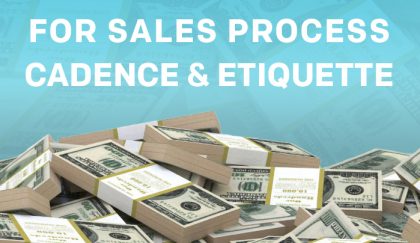5 Crucial Tips to Adopt for Every Sales Process

Have you ever wondered why a seemingly winnable sales process “suddenly” derails or comes to a halt? Chances are there were some very subtle red flags that were overlooked prior to reaching this boiling point. Whether you are working with a client on a long term project or pushing products door to door, there are a few industry courtesies and cadences that every business should adhere to to ensure a sustainable client relationship.
1. Not every client or prospect is ready to buy.
Not all prospects or clients will want to move through the sales process on your terms. If this is the case, don’t panic. If you have built a relationship they will think of you as a consultant, if and when they are ready to consider.
- Identify your potential client’s buyer’s journey. No matter where your potential client says they are in the sales process, as a consultant you need to personally evaluate their goals, current resources, and preferences.
- A prospect may have not even been aware that there was a decision to be made. A sales rep may think, “This client does not know about my product/service, so how could they possibly say no without giving me a chance?” This mindset is one-sided.
- Educate the client on their terms so they are more willing to listen. Provide helpful and informative information in order to open the door to client/ prospect communication. The more informative and noninvasive this information is, the more positive of a reaction your client may have.
- If the client or prospect does not take interest in the information provided, stop and listen. There could be a number of things the client may be sharing that could be alleviated. You may also find that your content is not as customized or relatable to your client as you initially thought.
The key to working with any client or prospect is education, patience, and an open ear. People are human; the less robotic you sound, the more positive of a reaction you will receive. The bottom line: personality matters. You want to be seen as a consultant, not a vendor. To be seen as an expert and thought leader in your industry you must first be seen as a genuine person who is interested in the elevation of your client’s company or well being.
2. Reinforce your credibility in the discovery phase.
After a client has agreed to consider or engage you for a project, you must clearly and concisely understand their expectations. The discovery phase covers the scope of what they want now but sets the stage for future projects, i.e. THE SCOPE OF WORK.
It is important to explain all of your skills and how they are related. This can be done by example dropping, such as, “We worked with another medical association and they are similar to you, here is the story, here is how it helped, and this is what we are doing now.” As long as you present your case studies with honesty and enthusiasm, you are reinforcing your credibility.
Additionally, during the discovery phase both the client and consultant are learning about each other. By sharing all aspects of your business or services as well as learning about theirs, you are creating a transparent working relationship. You not only establish trust for this project but for future possibilities as well.
3. Respect everyone’s timeline, including your own.
Validate the customer’s expectations. This stage is very important not only for deadlines, but for making sure they understand what they are getting. After validation, explain your timeline and scope of work.
Once the timeline and a clear scope of work is established, enforce it. A respectful cadence is necessary. A sense of urgency with followups, check-ins, and deadlines is key. Remember in this stage you are establishing your trust and reliability. Try to get ahead of the timeline, provide consistent updates, and provide progress even if there are speed bumps throughout the process. This will place you as the consultant in a proactive position. You can alleviate concern or distress by acknowledging each step with a plan of action moving forward. This will create a balanced relationship with open trust and communication.
4. Follow up and establish a continued relationship.
After validation, close, launch, and signing, incorporate quarterly check-ins into the timeline as well as one more follow up meeting to understand how the process was for your customer. Wrap everything up. Ask for a referral if it is positive, or ask for details on how you can do better if negative. This is very important to do face-to-face.
Continue the customer relationship following a project or purchase to strengthen the probability that they may look to you as a consultant or provider in the future.
5. Be prepared for anything, including failure.
The client or prospect may not make it to the final phase of the sales process, or they may buy…but not from you, and that is okay.
Each client or prospect has unique needs and relationships. You may not succeed with a sale or one relationship may be stronger than another. However, if you apply these best practices, your chances of building a solid foundation for potential opportunities will be much greater.
Want to improve your sales and marketing process? Work with WDG’s marketing and branding team. Feel free to contact us!